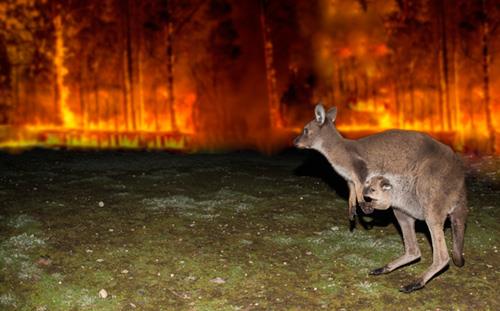
Late last week, officials closed Rocky Mountain National Park after a wildfire ravaged vast tracts of land across Colorado. The park is one of the most visited national parks in the country — or was, that is, until a blaze dubbed the East Troublesome Fire burned through some 100,000 acres of forest and grassland, prompting mandatory evacuation orders. The fire jumped the Continental Divide, leading one career firefighter with decades of experience battling fires across the US West to describe these recent blazes as "whole new territory."
It's impossible to watch the episode of PBS's Nature titled, Australian Bushfire Rescue (Wednesday at 8 p.m. ET, check local listings) — filmed during January's wildfires that devastated large tracts of pristine wilderness across what many geologists believe to be planet Earth's oldest, most isolated continent — and not think of this past summer's fire season that ravaged California, Oregon, and Washington State, creating a smoke cloud so vast it blackened the skies in Vancouver, Canada and extended far out into the Pacific Ocean.
Wildfires claim hundreds of thousands of animals — deer, foxes, coyotes, and other wild animals — while a handful of human volunteers do their best to provide respite for desperate, panicked animals, from creating impromptu animal shelters to nursing stricken animals back to health again.
These are the small, personal stories that rarely make it into the news headlines. As Bushfire Rescue makes clear, this is the way of the future, not a once-in-a-generation crisis.
First things first. Australian Bushfire Rescue is worth watching, if only because it's an intimate, personal view of a handful of animal rescuers trying their level best to do the right thing, without outside funding or government help but through their own sweat and toil, often as wildfires rage uncontrollably around them.
Australia presents an especially poignant problem because so many animals there are unique to that continent. If they go, that's it. Extinction is forever, as those in the climate change movement keep telling us, even as climate deniers — including numerous prominent politicians — dismiss the seemingly growing climate crisis as a hoax.
Australian Bushfire Rescue is not about one person's opinion, though, nor does it take a political position.
Rather, science broadcaster Anja Taylor, who also narrates the program, follows wildlife caretaker Adrina Selles and others as they take care of traumatized koalas, wombats, swamp wallabies, and bush kangaroos with the aim of releasing them back into the wild one day — provided that is that there is any "wild" left to release them back into. Selles is a former nurse who lives on New South Wales' south coast, who decided early on to do what she could for beleaguered wildlife near her home.
Nature is now in its 39th season. It's a standard-bearer for public broadcasting, and Bushfire Rescue shows why. This is no dry lecture. It's powerful, emotional stuff, and it's hard to watch and not come away deeply moved by the experience.
Bushfire Rescue hints, too, at a new direction for Nature as a series, and possibly for other natural history series as well. The film came about as a result of six digital shorts Taylor filed in January, at the height of the fire crisis, for Nature's website and PBS's online platforms. The future of entertainment is digital, and real-time shorts will play an important role in our new digitized world.
Scientists estimate anywhere from one to three billion wild animals perished in Australia's wildfires, but Bushfire Rescue recognizes the value of telling the story from the point-of-view of a handful of recognizable individual animals and the caretakers giving their all to save them.
In a Zoom conference call this past summer with TV critics from across North America — despite it being 6 a.m. in Australia at the time — Selles talked about how she was forced to evacuate her animal compound during the worst of the fires, only to be surprised when she returned.
Her tiny compound, surrounded by devastation, had been spared. She took it as a sign and redoubled her efforts to return nature to its former self.
"It was like coming back to a little oasis in the middle of black," Selles recalled. "There was our house and all the property around; it was still green. So amazing."
Rescuing animals isn't just about cute critters with big eyes, like wallabies and kangaroos. Selles also had to deal with goannas, possums, and a tiger snake, one of Australia's deadliest – this on a continent known for many of the world's most deadly snakes.
Taylor, for her part, recalled the Australia wildfires in terms anyone living in mountainous regions of California and Oregon this past summer will recognize in a heartbeat.
"There was an awful orange glow in the air every day, and everybody's cars were covered in brown dirt," Taylor recalled. "It was just a reminder of things going terribly wrong."
As hard as Australian Bushfire Rescue was to film, it was twice as hard to edit and put together afterward. It required constant moral decisions, Taylor admitted. She didn't want it to be a dirge, but she didn't want it to be Disneyfied, either.
"You want to tell a truthful story, but it is depressing enough as it is without going over injured animals and things dying over and over again. So we had to strike a balance.
"It was a rollercoaster of emotions. One moment we'd be confronting horrifically injured animals in the middle of the forest, and then we'd be watching the recovery of a wombat, which is just the most delightful creature — funny, curious, naughty."
Australian Bushfire Rescue is not just about the fires, she added.
"We wanted to show that uplifting side, where the animal actually recovers and is well cared for. We tried to present the balance of both, and hopefully, we succeeded."